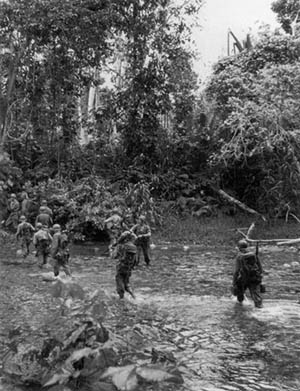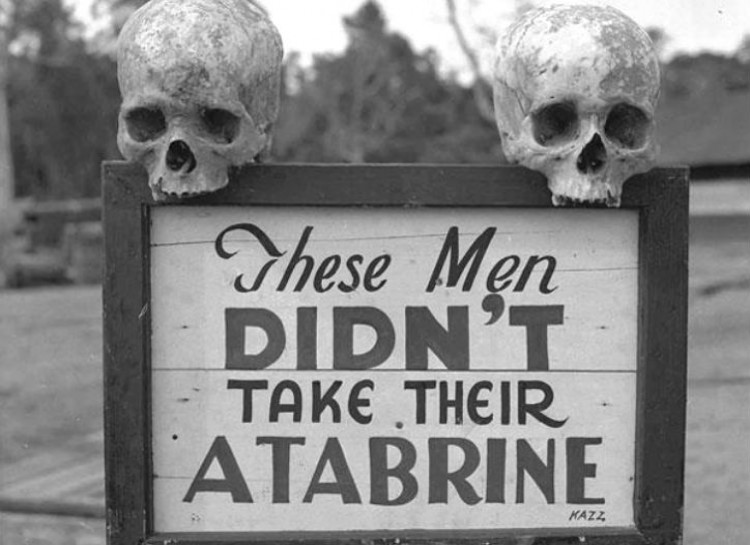Authors:
Historic Era: Era 8: The Great Depression and World War II (1929-1945)
Historic Theme:
Subject:
Fall 2017 | Volume 62, Issue 5


Authors:
Historic Era: Era 8: The Great Depression and World War II (1929-1945)
Historic Theme:
Subject:
Fall 2017 | Volume 62, Issue 5
Jim Duffy is author of the recent book, War at the End of the World: Douglas MacArthur and the Forgotten Fight for New Guinea, 1942-1945. He has also written books about FDR and Lindbergh, Lincoln's Navy, and the Czars of Russia.
Soldiers in the Imperial Army of Japan had a saying: “Heaven is Java; hell is Burma; but no one returns alive from New Guinea.”

For nearly four years, they struggled to hold onto the mountainous, jungle-choked island, fighting first with the Australians, then with Americans commanded by Douglas MacArthur. Because holding onto New Guinea was central to the Japanese strategy for the war, they poured a vast number of troops, ships, and warplanes into the effort, pulling away resources from other fronts that contributed to Allied successes elsewhere. Japanese generals interrogated after the war themselves concluded that the New Guinea campaign had contributed a good deal to their losing the war.
At the onset of the Pacific War, the Japanese moved quickly in the first steps to creating an empire across the entire western half of the Pacific Ocean and the Southeast Asian mainland. Four hours before Admiral Yamamoto’s carrier-based aircraft swept down on Pearl Harbor on the morning of December 7, 1941, air fleets from the Imperial Japanese Army attacked targets along the Malayan Peninsula, and a land invasion from the north followed quickly. Hacking through almost impenetrable jungle and across crocodile-infested waterways, the crack 25th Army fought its way south, pushing Allied defenders toward the island city of Singapore at the tip of the peninsula. Japanese troops occupied the entire 600-mile long peninsula in less than seven weeks, killing wounded Allied soldiers along their path. On February 15, Singapore surrendered, and more than 100,000 British, Indian, Australian, and Malayan defenders were plunged into brutal, often-fatal, captivity.
Japan’s forces also quickly toppled Wake Island, Guam, Hong Kong, the Philippines, and dozens of other locations in the central and southern Pacific and on the Asian mainland. Their goal was to seize and occupy resource-rich Southeast Asia, giving them access to the natural resources they lacked—iron, tin, coal, oil, bauxite, rubber, and rice. This would allow them to create a protective perimeter stretching from the Aleutian Islands in the north, down through the central and southern Pacific and around into the Indian Ocean. Tokyo’s propagandists called it The Greater East Asia Co-Prosperity Sphere. In reality, it meant that every person and every resource within that sphere would serve the Emperor.
Japan eliminated much of the potential interference from America and Britain by attacking Pearl Harbor and, three days later, bombing and sinking the Royal Navy’s two most powerful ships in Asian waters, the battle cruiser HMS Repulse and the new battleship HMS Prince of Wales.
in New Guinea struggled to keep roads open through the jungle." data-entity-type="file" data-entity-uuid="61601f8f-eae1-4ce2-8984-64127ec65be4" height="312" src="https://www.americanheritage.com/sites/default/files/inline-images/EngineersnearSaidor.jpg" width="429" loading="lazy">
Flush with victory, Tokyo’s war planners then turned to the question of Australia, the logical place for U.S. and Allied forces to prepare a counterattack. The country was large enough to hold hundreds of thousands of troops and huge amounts of war materiel. It offered deep-water harbors as well as numerous airports from which to sortie. The Japanese knew they had to neutralize Australia, either through invasion and occupation, or by cutting her supply and communication lines to the United States.
The key to reaching Australia was New Guinea, the second largest island in the world, which sits just 93 miles north-northeast of Australia at the closest point. If the Japanese could control airfields along the southern coast of New Guinea, especially at the capital of Port Moresby, their bombers would be within range of Australia’s vital Melbourne-Brisbane coastal belt. From New Guinea, Japan could accomplish Prime Minister General Hideki Tojo’s goal of “throttling Australia into submission.”
Capturing and holding New Guinea, only 93 miles from Australia, was critical for Japanese war planners, who hoped to “throttle Australia” while her troops were fighting in North Africa, Greece, and elsewhere.
With most regular Australian Army, Navy, and Air Force combat units fighting in Greece, North Africa, and the Middle East, both New Guinea and Australia were particularly vulnerable. Their defense consisted of volunteer militia and support troops. Japanese planners knew it would take months for the crippled American Navy to train and ship forces across the Pacific. The time to strike New Guinea—the gateway to Australia— was now.
From January 23, 1942, when their soldiers first landed on New Guinea, until the last holdouts in the mountain jungles surrendered on September 11, 1945 nearly four years later, the fighting was virtually nonstop. The Japanese would pour 600,000 soldiers into the mire of New Guinea, along with dozens of warships and hundreds of aircraft. The more resources they committed, the more important the campaign became to the Imperial General Staff.
For Americans, victory in New Guinea was the vital first step in the long march through the Philippines to the Japanese home islands and the ultimate destruction of the Japanese Empire. Winning the war in New Guinea was of personal importance to Allied Commander-in-Chief General Douglas MacArthur. His avowed “I shall return” to the Philippines could only be accomplished after taking New Guinea. It was four years of some of the worst warfare in history, fought in monsoon-soaked jungles, debilitating heat, impassable mountains, torrential rivers, and animal, insect, and disease-infested swamps -- what one American soldier called “a green hell on earth.”
